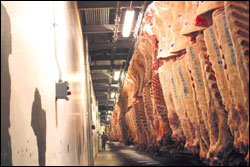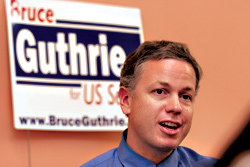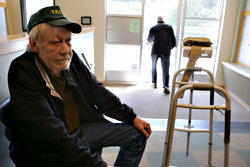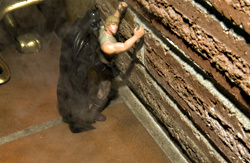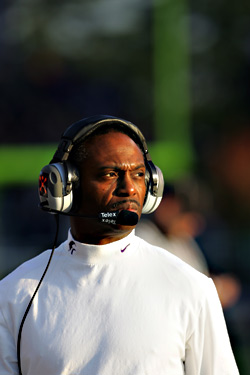The cow steps forward on the cement. She is black, an Angus heifer, and weighs around 1,300 pounds. She’s wedged in a chute against a steel plate. A couple dozen more cows are behind her, all of them headed for the knocking box. There, she and the others will be killed and begin a transformation into something fit for a dinner plate.
She’s not struggling or agitated or mooing. The plate lifts, and she walks forward. The steel closes behind her. She stands there at the bottom of the box. No alarm registers on her face or in her body. Above her, a man known as a knocker reaches for an oblong metal device attached to the ceiling. It is called a captive bolt gun, and this is what the knocker will use to kill the cow.
“I want you to count,” Gary Hyatt says to me. He’s the manager of the processing division—OK, slaughter operations—at Washington Beef in Toppenish, Yakima County. “Count how long it takes till the cow is down.”
The knocker centers the gun over the heifer’s crown. She looks to her left. You feel a slight twinge at this moment. You know what comes next. Pfffffffft goes the pneumatic gun.
She hits the deck before my mouth can begin to form “one,” quicker than you can snap your fingers. The cow is flipped out of the box onto an adjoining floor. She lies on her side. Her legs stick out, straight and motionless, and blood runs from the hole in her forehead and out her nostrils. A man attaches shackles to her rear legs, and she is hoisted into the air. Her tongue flops out of her mouth.
I couldn’t be more pleased. I am a meat-eater who, for years, has seen the PETA videos of slaughterhouses where the killing verges on torture and has felt somehow implicated. This isn’t that torture. The cows come to their deaths too calmly to call it that.
But for several million American vegans and vegetarians, it does not matter how humane a place like Washington Beef is at killing. To them, killing living creatures for food is wrong—it’s murder, it’s torture. Ipso facto and prima facie. For many, going vegetarian, vegan in particular, is the appropriate response. It beckons as a way to a purer, more compassionate life defined by a purely secular expression—the menus of breakfast, lunch, and dinner.
Over the past 15 years, such reasoning has attracted so many adherents that an estimated 5 percent of the American adult population is either strict vegetarian or vegan. The phenomenon principally exists in coastal urban areas. But across the country, vegans and “vegs,” as they are known, have had a direct and powerful influence on what the rest of Americans eat and how they think about food.
LIKE OTHERS ALERT TO INTELLECTUAL and philosophical shifts, I’ve done a lot of thinking and reading. I’ve read Peter Singer. Over the years, I’ve interviewed and casually chatted with scores of vegetarians and vegans about why they do what they do. Almost always, it comes down to a core disgust with how farm animals are raised and slaughtered, that the animals are too thinking and feeling to be treated that way.

Rachel Bjork road a bicycle 3,600 miles to protest the treatment of KFC–bound chickens. |
As a result, I’ve flirted with veganism twice. I’ve also tried vegetarianism. Each time, I returned to meat and dairy. What’s more, I have my doubts about endowing each cow or chicken with so much intelligence and feeling that we need to develop a social compact that translates into not eating meat. But I am equally troubled by factory farming. Maybe those PETA videos are right.
Rachel Bjork, a vegan who does outreach and education for Seattle’s Northwest Animal Rights Network (NARN), says the videos are right. She tells me that cows are alive the length of the slaughter line. And she just doesn’t understand people like me—people who know the whys of veganism and vegetarianism yet continue to eat of the cow. I, too, am getting tired of the cognitive dissonance of it all. Can meat-eating be ethical?
For Bjork, these are her salad days. Mad cow is in the air. When Bjork and other NARN members hand out “Go Vegan” flyers on Seattle’s sidewalks, about 50 percent of passersby take the literature. A year ago, their hit rate would have been closer to 20 percent. If all those people read those flyers very closely and put vegans and vegs in their proper social context, they will realize that vegans and vegetarians are meat-eaters’ best friends.
‘Bomb McDonald’s’
We kill animals all the time. We’ve done it for many thousands of years. The slaughter of animals—whether through the hunt or the family farm—has long been intertwined with being human. The West wasn’t won on a diet of tofu and sprouts. Slaughter has played a key role in human rituals for centuries. In the Odyssey, whenever anything good happened to Odysseus, he’d sacrifice a jet-black sheep to the gods. A Thanksgiving turkey fulfills largely the same purpose these days.
But at various points in human history, some people have said that meat-eaters have it all wrong. We have no right to inflict suffering upon other living creatures in order to sate our appetite. In the sixth century B.C., the mathematician Pythagoras formed a group known as the Society, which espoused vegetarianism. On the Indian subcontinent, vegetarianism has been around for as long as 3,000 years. But except for a few specialized social groups, in North America vegetarianism has long been a fringe belief, easily dismissed as something Seventh-Day Adventists did and do.
That changed in the early 1970s, a time of intellectual ferment in America. A spate of books challenged meat-based diets and the treatment of farm animals. There was Ruth Harrison’s Animal Machines, Frances Moore Lappe’s Diet for a Small Planet, and, most influentially, Animal Liberation by Australian ethicist Peter Singer. The books came during a period when many in the industrialized world had begun to question mankind’s management of Earth, spurred partly by the dire forecasts in what’s known as the Club of Rome report. Initially, the change that was in the air translated into small grocery stores and co-ops for vegetarians or shoppers who at least wanted organic produce. Restaurants began to offer “the vegetarian option.” But typically, vegetarians were quiet about their diet.

Washington Beef’s Toppenish plant processes 250,000 head of cattle a year. Cows are killed with a captive bolt gun, stripped of hides and organs, and cut into steaks—all under one roof. (Stephen McFadden) |
Vegans, who eat no animal products whatsoever, came along loud and proud in the mid-1980s. The straight-edge punk-rock community, especially in the Washington, D.C., and Salt Lake City areas, actively embraced the vegan way. By the early 1990s, veganism had spread well beyond the hard-core punk community to the broader culture. In some urban areas, it became as much a proof of one’s coolness as tattoos and piercings. For many vegans, diet became a sociopolitical battle cry, particularly among anarchists in Portland and Eugene, Ore.
TWO YEARS AGO, for example, Eric Schlosser read from his Fast Food Nation at a Portland bookstore. At one point, a young woman stood up and proclaimed herself a “brand-new vegan.” You knew what was coming next. “And I think we all ought to go out and bomb McDonald’s,” she said.
This agitation against the standard- issue American menu came at a time when the meat and dairy industries were themselves going through a major transition. For much of its history, the dominant paradigm in meat and dairy production was good, common-sense animal husbandry. You treat the animal well and let it grow naturally, and the animal will take care of you. It was a social contract that seemed to be largely in balance up through the 1970s.
But something zigged in American business just about the time the American diet began to zag. The MBAs took over the world of commerce. To these guys, principles like stewardship and husbandry were expensive frills. They set out to squeeze every last dollar from animal production. Three years to bring an Angus to slaughter? Make it 18 months—and feed it grain so it gains weight faster.
Within a century, America had gone from cowboys with grazing cattle on the open range to ranch-based but respectful industry to full-scale factory farming on the order of Ford’s famous River Rouge assembly plant, where iron ore went in and cars came out.
Even to a meat-eater, it all looks a bit too unnatural. For activists like Bjork and advocacy groups like People for the Ethical Treatment of Animals (PETA), the meat industry has made an easy target.
Compassion vs. Murder
Late last summer, Bjork quit her job as a project manager at a medical company. She climbed onto a Raleigh 21-speed hybrid bike and set out to protest at every KFC she could find between Seattle and Norfolk, Va. It was a 3,600-mile ride. Her trip was part of PETA’s campaign against the fried-chicken giant. PETA accuses KFC of failing to urge chicken ranchers to halt such practices as debeaking them and housing them in battery cages.
I meet with Bjork for coffee in Fremont. She is 32 years old and has the aura of Scandinavian cool that marks many native Seattleites. When she returned to Seattle in November, she became NARN’s outreach director, responsible for the group’s regular leafleting expeditions around Seattle. Bjork is paid a half-time salary, but she puts in full-time hours and then some.
She tells me that she protested in cattle-country cities like Sheridan, Wyo., and Garden City, Kan. I ask her what kind of response she got. She says it wasn’t as rancorous as you might imagine, although occasionally a burly young man with a sunburned neck would shout an insult from the window of a pickup. She was surprised to find Silk-brand soy milk in a store in Wyoming.
But I’m not there to talk milk analogs. I’m there to talk meat. I tell Bjork that I know about animal slaughter. More specifically, I say that I witnessed what are known as “field slaughters” a couple of times when I was a young child. Hell, my father’s family raised and slaughtered animals in Arizona from the 1860s through the 1970s. And, oh yes, I remind her that I know the ethical and philosophical arguments for vegetarianism and veganism yet am comfortable eating meat and cheese—that I’ve tried the plant-based life and found it wanting. What does she think of that?
“People who know all the issues and don’t change—I just don’t understand it,” Bjork says. “Wouldn’t you rather go through life knowing that nothing had to die for you to eat?”
My answer is no.
“If you continue to eat animal products after you know—that’s selfish,” she says.
THAT’S THE DEAL with vegans and, to a lesser degree, vegetarians: They know. You don’t. They own the moral and ethical high ground in the American diet. You don’t. They are saving the Earth. You are destroying it. They are compassionate. You are a murderer.
“Who’s to say ‘I’m more important than that cow’?” Bjork asks. “Who says I have a right to kill that cow or shrimp? Because I can pay someone to raise it and kill it for me? If a meat-eater is not willing to kill the chicken, pig, or cow, then they shouldn’t be eating it. It’s too much denial.”
How did mankind’s consumption of animals become worthy of moral scrutiny 30 years ago, I ask. How did a traditional activity suddenly become a crime in 1975?
“Because we know better,” she says. “We don’t have to eat animals to survive.”

At Dave Boon’s dairy in Mount Vernon, all the cows appear to be happy. “Contented cows give good milk. We have no incentive to do anything to the contrary.” (Philip Dawdy) |
There’s a piece of me that can understand the intellectual appeal of the meatless, nondairy diet. It is a way to frame your life in starkly moral terms. You can be assured of doing the right thing each time you go to Puget Consumers Co-op. In a postmodern world, where most of us have little control over the grindings of the universe, food is one place where you and I can both exert a large measure of control and affect the marketplace in ways that a protest at Westlake Park never could.
Which brings me back to the slaughterhouse.
The Disassembly Line
Earlier this month, I drove to Toppenish. It’s a windblown town, 20 miles south of Yakima. Just off state Highway 97 and across from the Yakama Nation’s Legends Casino sits a low, dun-colored building. Windowless, it is long enough to span several city blocks. It could almost pass for a microchip-fabrication plant, but then there’s the cyclone fence topped with three strands of barbed wire and cameras that control the gated entrance to the parking lot.
Washington Beef and the Washington State Beef Commission invited me here. My impetus for requesting a tour of the facility was because of the claims made by Bjork, PETA, and many others about inhumane treatment of cattle. To the degree that you can from a controlled media tour, I wanted to assess whether there was any truth to that.
Washington Beef processes 250,000 head of cattle each year. That makes it the second-largest slaughter facility in the state—behind the 750,000-head Tyson plant in Pasco—but only a medium-sized facility compared to some of the immense places in Colorado and Kansas.
After an introductory meeting with plant officials, I am led to a small dressing room. I put on a white smock, hair net, hard hat, and calf-high rubber boots. I will be stepping in something.
Gary Hyatt, the processing manager, leads the way. He shows me outdoor holding pens. Instead of bare earth, the pens are lined with grooved concrete to keep cows from falling down. Two dozen heifers in one of the pens seem to be neither agitated nor anguished. There is no mooing, considered by many experts to be a sign of cow distress.
THE SLAUGHTERHOUSE is divided into two parts: the slaughter line and fabrication, as it is known. Hyatt leads me toward the slaughter line. As I described earlier, “drovers”—yes, they still call them that—herd cows into a chute that leads to the knocking box. There, I watch as the knocker kills seven cows, each on the first shot. I watch each cow get rolled into the shackling area. From about five feet away, I can see no signs of struggle, much less life. On one, the left-rear leg twitches slightly, consistent with postmortem nerve impulses. Other than that, each is shackled without a problem and hoisted into the air and swung over to the sticker.
The sticker takes a short knife and makes a cut on the cow’s hide in the chest area. It’s a process called “opening the pattern.” Then the sticker takes another knife and severs the cow’s jugular vein. Blood pours forth as if a wine bottle had been overturned. The blood sluices away into the nether reaches of the factory—for make no mistake, this is a factory, one that disassembles cows.
None of the knocking and sticking bothers me. And as I begin to turn and take in the enormity of the slaughter line—dozens upon dozens of upside-down cows going by on hooks—what unnerves me is the smell. There is no precise name for the slaughter smell, even within the industry.
“It is what it is,” says Hyatt.
But it would surely have to be a mixture of blood, feces, urine, stomach juice, etc. It is the most intense smell I’ve ever encountered in my life. By comparison, a pulp mill smells like a rose garden. Making it even more oppressive is that it’s well over 90 degrees on the slaughter line, the result of so many cows with a body temperature of 99 degrees being sliced open. I don’t want to know how hot it gets in the summer.
Beyond that, a slaughter line is an image-rich environment, to say the least. Strangely, I found it fascinating to watch how tightly engineered the process has become. It resembles an assembly line of sorts. Workers wear hard hats, eye protection, white smocks, and rubber boots. Each has two knives attached to their waist. Cows come in and have their hides stripped off at a series of stations. There are steam and pneumatic blasts everywhere. Suddenly, a set of hydraulic arms pulls the last of the cow’s hide from its carcass, all in one piece. It is then transferred to an overhead conveyor belt and sent through an opening in the plant’s wall, where it falls into a dump truck.
You see cows in all manner of poses. A series of cows moves along the line at one point, their abdomens slit open with stomachs and intestines uniformly hanging out. At another point, the cows are beheaded. Their heads are then hung on J-hooks and circulate on a separate line, where the age of the cow is established by checking its teeth.
Soon after, the carcass arrives before a worker holding what looks to be a giant C-clamp hanging from the ceiling. Between the clamp’s ends, a band saw circulates. The worker lines the saw up along a carcass’ spine. He moves the saw through the bone. Now there are two sides of beef. The process takes less than 30 seconds.
Throughout the line, U.S. Department of Agriculture inspectors examine the carcasses.
FINALLY, THE SIDES enter a large stainless-steel enclosure that looks much like an industrial freezer. Inside, the side of beef is exposed to 180-degree heat—theoretically enough to kill any E. coli or other bac- teria on the meat. The carcass emerges slightly blanched.
The side then hangs for 24 hours in a refrigerated warehouse. Here, the USDA grades the beef.
Later the beef passes into a separate part of the facility, called fabrication. It’s where the side of beef is cut into “subprimals”—loins, roasts, chuck rolls, and the like. Three hundred people work in the “fab” room, spread out along a series of lines. Each line cuts up a separate portion of the carcass. The workers, most of them Latino, wear smocks, hard hats, eye protection, and gloves with plastic gauntlets that go up their forearms. Under their smocks, the workers wear bulky clothes. It is 42 degrees in the fab room. They hardly ever look up from the beef they cut.
The floor is covered with beef fat. At the end of the day, it takes an entire eight-hour shift for 10 people to clean this room.
After that, the cuts are vacuum-sealed and placed in boxes. The boxes are stacked in another warehouse—boxes to the ceiling as far as the eye can see.
Overall, I was impressed by the facility and how the workers handled the cows, both dead and alive. The cows died in a humane way. The slaughter line was surprisingly clean.
To be fair, I was seeing a model facility. I’m sure there are some problem slaughterhouses around the country. How else would PETA and groups like Compassion Over Killing get so much undercover video?
He Does a Cow Good
A week later, I visit Dave Boon’s dairy in Mount Vernon, up in Skagit County. He’s been in the business for 29 years and produces milk for Darigold. He owns 300 head of cattle, mostly Holsteins, with a few deer-faced Jerseys thrown in. His farm comprises 50 acres, and Boon leases another 200 where he grows corn for silage. For each of the past two years, he’s borrowed against the equity he has in the land to keep his farm going. Only in the past six months has Boon turned a profit.
This is not an industrial dairy, unlike the 15,000-head complexes in California and Idaho. In fact, it’s almost average in size for Washington. A light smell of manure and cow feed fills the air. Boon feeds his cows a mix of alfalfa, silage, oats, and other grains. The odor is exotic.
Boon and I walk around his farm. He is about 6 feet 3 inches tall and looks as though he’s been bucking hay bales for much of his life. I ask him about the rhetoric around dairies.
BJORK AND OTHER vegans I’ve spoken with tell me that dairies are more evil than slaughterhouses. They speak of mistreated animals. Calves snatched from their mothers right after delivery. And don’t you know that milk is bad for you, that the dairy industry has been brainwashing Americans for decades? And that milk is theirs, not ours!

Dining with vegans, clockwise from here: Rachel Bjork (left) offers her mother, Ann Bjork, a taste; Rob Gilbride shows off a meat “analog” product; and Jessica Peters stirs a vegan pot. |
“Contented cows give good milk,” he says, by way of explaining that his cows are well treated. “We have no incentive to do anything to the contrary.”
Boon shows me almost every cow at the farm. I see Holsteins feeding under huge awnings, Holsteins lying in their stalls and chewing their cud, Holsteins in the milking parlor. He leads me past pregnant Holsteins, postpartum Holsteins, Holsteins that are ill (and off the production line, to be sure). I also see at least two dozen calves, some as young as a week old. Their coats glisten in the morning sun.
I look at each cow as carefully as I can. I see no runny eyes, hide cuts, or rub marks anywhere. In terms of husbandry, these look to be well-cared-for creatures.
So why is it wrong for you and me to drink their milk?
A Moderate View
Bernard Rollin has been thinking and writing about such issues for more than two decades. He’s a professor of philosophy at Colorado State University, one of the principal architects of the 1985 Animal Welfare Act, which covers lab animals, and he has written several books on the ethical soup around animal issues, applying philosophical reasoning to what he encounters in today’s animal industry. It’s a bit like Hegel meets the slaughterhouse.
In Rollin’s worldview, what mankind owes animals is the ability to live as naturally as possible—that we let cows be cows and chickens be chickens, that we respect and nurture the animalness of animals. Then we can eat them without moral qualms.
“Literally, that’s the way things were when we had a fair contract with animals,” Rollin says. He refers to the relationship between man and farm animal only a couple of generations ago. “But once we could override it with high-tech, we did.”
The factory farm paradigm of many agriculture corporations concerns him, as did the conditions for laboratory animals. It’s disrespectful of the animal’s being, not to mention the animal’s physical welfare. What’s interesting, Rollin says, is that some cattlemen have begun slowly to come around to that way of thinking, although only in whispers at animal-care conferences.
So how’s an intelligent person to respond to a world of absolutes, of factory farms versus vegetarianism and veganism?
“The idea of everyone becoming vegan or vegetarian is so outlandish that I don’t consider it to be a viable solution to the farm welfare problem,” Rollin says. “A good agricultural situation would be the restoration of husbandry.”
In other words, treat the animal well, and it treats you well.
It’s a centrist position—a middle path between the absolutes of animal argument.
“He kind of captures what the everyperson can live with,” says Candace Croney, an assistant professor of animal science at Oregon State University. “Let animals live as nature designed them to live. Then it’s OK to use them. Any reasonable person on the street can understand that.”
Dinner Is Served
On a recent evening, I join a group of vegans for dinner at a house on Capitol Hill. A week before, I had challenged Bjork to prove to me that vegan food actually tasted good. I didn’t mean Cafe Flora cooking, either. I was interested in meals the average home cook can create.
And so six women set about preparing what looked to be a lovely dinner (men in attendance did not cook). The mood is festive, almost like a holiday. There is a chowder composed of tofu, celery, corn, and soy milk bubbling away. Marinated tofu is sautéed on the stove. Sarah Schmidt is making what she calls country-fried tofu. Someone mentions white Russians made with soy milk.
I ask Schmidt about the day-to-day practicalities of veganism. Is it easy to find a meal?
Schmidt, who works in Belltown, ticks off a couple of places where she can score vegan food within walking distance of home. One is a market selling prepared vegan sandwiches, the other is Taco del Mar, where she can get a vegan burrito. Other than that, life can be a hassle.
“It’s hard to live on the high ground, looking at everything you buy, asking waitresses, ‘Does it have meat? Does it have dairy?'” Schmidt says.
Like other vegans I’ve spoken with, Schmidt admits that not being able to eat cheese “hurts.” Another in the group whispers that she loves cheese as well, and on rare occasions backslides. “But don’t tell anyone,” she says.
Bjork shows me packages of what are called “meat analogs,” a euphemism for fake meat. In one are slices of pseudo-bologna, in another pseudo-turkey slices. The bologna tastes OK. The turkey is awful.
WHEN WE SIT DOWN to eat, I tell them about my visit to the slaughterhouse and that I think it’s about as humane as you could ever make the process.
To varying degrees, they answer that a humane slaughter still means that the cow is dead. And so it is.
I listen to them tell me about which musicians are vegan. You know someone is dead serious about a cause when they start identifying with celebrities within their movement. I ask how many of them have read Animal Liberation in its entirety. Not a hand goes up. It’s 50-50 on Fast Food Nation. (Schlosser told me two years ago that he is a meat-eater, one who’s very critical of the meat industry.)
For years, I’ve encountered vegans and vegetarians of every stripe. Ones who’ve read the movement’s essential texts and those who know them by reference only. Some have walled themselves off in vegan communities, most prominently in Washington, D.C., and Portland.
It is a very hard choice to go vegetarian or vegan. Some have told me it feels almost like falling off a cliff when you cut yourself off from meat and dairy. Some vegans and vegetarians react to that separation from what they call SAD—the standard American diet—by walling themselves off socially from omnivores. I know a vegetarian who will not kiss a meat-eater, for example. I know vegans who will only dine with carnivores under duress.
To a person, they are passionate about their reasons for ditching meat and dairy. But I’ve seldom heard vegans get passionate about the taste and texture of the food they eat.
The food before me was certainly prepared with care and compassion. But it doesn’t have the power or intensity you’d want with a pleasurable meal. Chowder made of tofu and soy milk is just wrong.
BUT IN THE YEARS to come, there will be more and more faux chowder in stockpots. The market for all the so-called meat and dairy analogs was estimated at $1.5 billion in 2002, according to the Mintell Consumer Intelligence company. For perspective, that’s the approximate value of all apples harvested in the U.S. each year.
Veganism and vegetarianism have caught on among teens and twentysomethings. Statisticians are having a tough time tracking it, but there are studies, estimates, or claims that suggest that 37 percent of teens don’t eat red meat (twice the number of 40 years ago), that about 1 million teens were vegetarian or vegan in 2002 (double the number of 2001), and that 10 percent of 15- to 18-year-old girls say they are vegetarian.
The meat industry knows something is up. In 2002, the National Cattleman’s Beef Association launched zip4tweens (www.cool-2b-real.com), a Web site aimed at 8- to 12-year-old girls that has gentle suggestions all over to consume beef products.
The dietary dialectic is everywhere, including the home of Washington Beef President Gayland Piederny. When his daughter moved to Seattle a few years ago to attend Seattle University, she went vegetarian. It led to spirited discussions between father and daughter—”speeches,” as Piederny remembers them. At home one Christmas, however, Mrs. Piederny encountered her daughter raiding the refrigerator late one night. There were leftovers of prime rib in the fridge, which the daughter was eating. She is no longer vegetarian, her father says.
You can see signs of it in every supermarket, too. Ten years ago, there was no soy milk or rice milk at mainstream stores. There is now. And if there were not a market for the dairy analogs, they wouldn’t be there. Vegans and vegetarians must also be credited with the vast improvement in the quality of supermarket produce over the past decade.
You can see the signs elsewhere, including the slaughterhouse that I toured. All the steps taken to ensure that the cows go to their deaths calmly and without struggle came about because PETA hammered away at McDonald’s for years about humane handling at its beef suppliers’ facilities. McDonald’s then required its suppliers to meet a series of humane handling standards much stricter than those enforced by the USDA.
That’s the best thing to happen to meat-eating in a generation. Maybe it will prompt the meat industry to get back to old-fashioned animal husbandry.
When we get there, I will thank the vegans and vegetarians. Then I will eat a steak.
